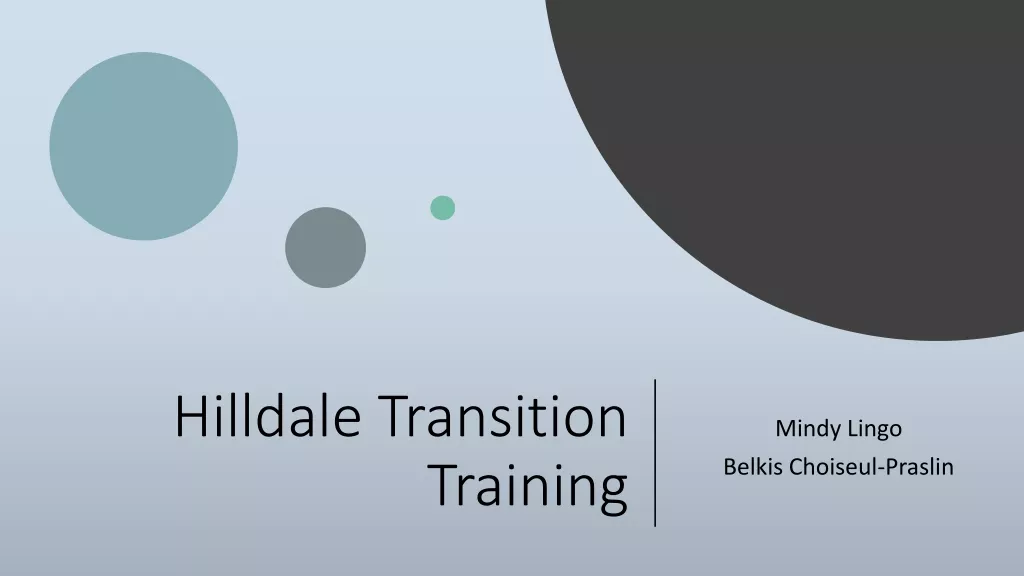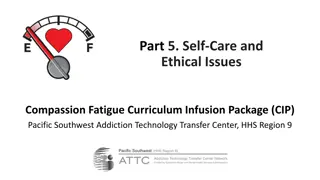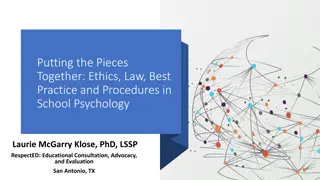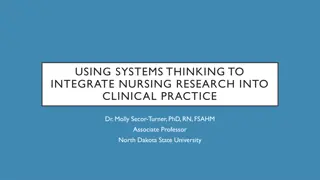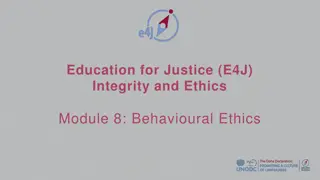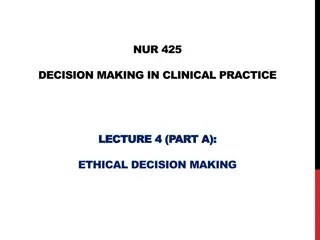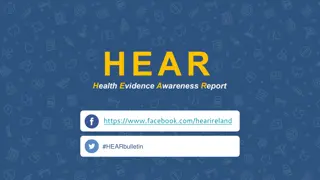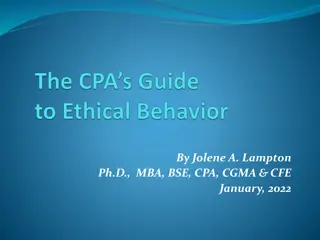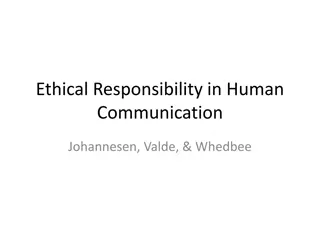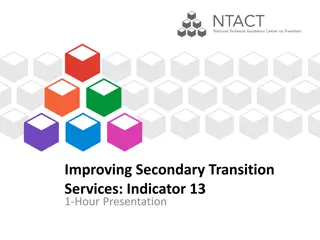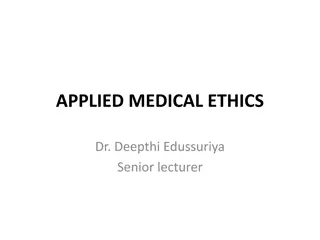
Ethical Considerations in Evidence-Based Practice for Transition Support
This presentation delves into the intersection of evidence-based practice and ethical considerations within transition support at the Ethics in ACTion Conference 2014. It explores the challenges, system pressures, and client-centered approaches in ensuring quality care while respecting autonomy and funding outcomes. The session addresses issues such as client discharge, ongoing themes of concern, research needs, and the lifelong process of recovery in the context of transition support.
Download Presentation

Please find below an Image/Link to download the presentation.
The content on the website is provided AS IS for your information and personal use only. It may not be sold, licensed, or shared on other websites without obtaining consent from the author. If you encounter any issues during the download, it is possible that the publisher has removed the file from their server.
You are allowed to download the files provided on this website for personal or commercial use, subject to the condition that they are used lawfully. All files are the property of their respective owners.
The content on the website is provided AS IS for your information and personal use only. It may not be sold, licensed, or shared on other websites without obtaining consent from the author.
E N D
Presentation Transcript
Is evidence based practice on transition mixing well with ethical practice? Ethics in ACTion Conference 2014 Ontario ACTT Association Tracy Bellamy,Gary Cuddeback, Bill Dare, Susan Farrell, Andrea Lefebvre, Janice McFarlane, Brendan McCormick
Agenda Outline 1. Why discuss transition at an ethics conference? 2. Issues in Transition 3. Evidence Based Practice in Transition 4. Overview of the ATR 5. Eastern Ontario ACT Network Pilot use of the ATR and Results 6. Ethics in ACTion: Team Function, & Focus Transition Risks Changing needs of person over time Relationship with Client
WHY DISCUSS TRANSITION AT AN ETHICS CONFERENCE?
Everyday system pressures to effect transition from ACTT teams experience System Flow; ACTT services within the LHIN and mental health system; Recovery Plans; Assessment tools Fidelity & Standards of ACTT Right care at the Right Time Stigma of mental illness social exclusion
Question for consideration In a program that is funded to reduce hospital bed days, how do we ensure that autonomy is respected and that we remain client centred in supporting clients to achieve quality of life, while also being accountable to funding outcomes?
Ongoing themes of concern that keep coming up with teams about transition Discharge to where? What happens to client as will get sick in a few years? Quality of care by new group, will not be as good as ACTT. Impacts on client of loss of the relationship with the team We need to understand the client, beyond their involvement with the ACT Team We have an aging group with a lot of physical health issues Recovery is a lifelong process and ACT model supports this
EVIDENCE BASED PRACTICE IN TRANSITION
Research needs to catch up to practice ACT for Life vs. recovery orientation ACT transitions literature mixed; range of designs; small, local samples; limited outcomes; few standardized measures; transition criteria unclear No, you can t (transition) - Audini et al., 1994; Stein & Test, 1980 Yes, you can (transition) - McRae et al., 1990; Rosenheck & Dennis, 2001; Salyers et al., 1998; Susser et al., 1997 No standardized measures specific to ACT to help identify transition-ready consumers
Development of the Assertive Community Treatment Transition Readiness Scale (ATR) Part of larger study of transitions from ACT1 Developed items for ATR from: Qualitative and quantitative findings Focus groups with ACT staff Examination of outcomes for transitioned consumers Review of literature and relevant measures Review of available guidelines on www 1. Supported by grants from the Ohio Department of Mental Health and The Health Foundation of Greater Cincinnati
EASTERN ONTARIO ACT NETWORK PILOT USE OF THE ATR AND RESULTS
How pilot teams participated Over the three years,10 teams participated We provided Feedback to each team about aggregate ATR data results and demographic characteristics via a Team Profile (teams used their own unique identifiers for clients) Encouraged use of the ATR in service planning/OCAN (leave copy in file) Teams encouraged to identify Clinical and Structural (systems) issues
Sample size & Teams involved over 3 years 2012 2013 2014 All 3 years n = 535 n = 462 n = 602 n = 1599 Sample size The Royal: ACTT Catherine ACTT Bank Step Down from ACTT + Renfrew ACTT + SDG ACTT + Summit ACTT Teams involved - Brockville - Montfort ECTI Pinecrest-Queensway Prescott-Russel Brockville Montfort ECTI Total teams 7 teams 7 teams 8 teams 10 teams
Example team ATR scores profile 2012 Relationship b/w ATR scores & years w/ACTT ATR Score (M(Range) Group A: ATR < 43 needs high support Group B: ATR = 43-50 moving towards recovery NS r = 0.18** r = 0.16 ** 47 (32-65) 49(23-71) 48(23-70) 24.7 % 21.4 % 25.6 % 48.1 % 38.9 % 40.7 % Group C: ATR 51-58 obtained wellness (?), transition potential (?) 18.5 % 28.6 % 24.0 % Group D: ATR > 58 Why still on team (?) 8.6 % 11.1 % 11.1 % Note: * < 0.05, ** < 0.01
Example team characteristics profile 2012 Indicator Team (n=81) Total Sample (n=535) 50.9 % 51.6 % 47(17-80) Total minus Step-down (n=445) 52.1 % 56.2 % 46(17-80) Male Caucasian: Age (M(Range)) Diagnosis Schizophrenia Mood Disorder Concurrent Employment (No) Yrs. w/ACT (M(Range)) 9+ years w/ACT 61.3 % 82.5 % 44 (21-71) 95.0 % 1.3 % 68.4 % 88.8 % 6 (1-12) 27.5 % 78.3 % 10.5 % 35.0 % 87.8 % 6 (1-22) 29.6 % 77.3 % 11.2 % 38.6 % 90.7 % 6 (1-22) 22.6 %
Average ATR score & Group frequencies 2012 2013 2014 All 3 years ACTT SD ACTT SD ACTT SD ACTT SD (n=442) (n=90) (n=363) (n=97) (n=507) (n=93) (n=1312) (n=280) 47.5 54.0 46.0 54.3 47.1 53.5 46.9 54.0 Average ATR Score % of clients in each group: Group A 25.6 % 1.1 % 34.2 % 5.2 % 27.6 % 8.6 % 28.7 % 5.0 % Group B 40.7 % 30.0 % 37.2 % 22.7 % 39.4 % 20.4 % 39.3 % 24.3 % Group C 24.0 % 51.1 % 20.9 % 44.3 % 25.0 % 48.4 % 23.6 % 47.9 % Group D 9.7 % 17.8 % 7.7 % 27.8 % 7.9 % 22.6 % 8.5 % 22.9 %
Is there an association between the number of years with ACTT and ATR score? Using data from all 3 years: R = 0.13** Yes, the relationship is statistically significant. In other words, a higher number of years with ACTT is associated with a higher ATR score.
Biomedical ethics The study of the theoretical foundation of rights and obligations in health care relationships between various health care professionals and the patient and the practical moral issues arising in these relationships (biomedical Ethics, Fisher, 2009) The Champlain Center For Health Care Ethics
Four principles of biomedical ethics Respect for Autonomy ( the ability of the individual to govern themselves, formulate own life plans) Beneficence ( to do good or help) Non-malficence (do no harm) Justice (the duty to give each situation/person equal consideration)
Ethical considerations in ACTT work Paternalism in our work( the policy or practice on the part of people in positions of authority of restricting the freedoms and responsibilities of those dependent on them for their supposed interest F2009)...ATR Bias in ethical decision making ( when there is a lack of a clear framework in which to make decisions we revert to our own values Wagner 2012)
TEAM FUNCTION AND FOCUS Team pilot case Prime list matrix Alternate functions Workload Measurement Tool Caseload Balance Reference Tool Scheduling & Redistribution
ACTT Worker Caseloads According to Client ATR Scores (July 2014) ACTT Worker Caseloads According to Client ATR Scores (July 2014) Carl Jen Kelly KJ Donnie Amber Ethan Isabel A A A B Marie Briana Emma James A A A B Merrill Charlotte Frank Jessie B A A C Jimmy Aiden Fern Kahn C B A C Alan Bailey Grace Kathy C B B C Jay Caleb Gary D C B Wayne Denise Harry D D C George Henny D C Olive Isaac D D Brendan Matt Kirk A Spock A Scottie A Pavel A Uhura B Sulu B Bones C Megan R Chewy A Anakin C Leia C Luke D Han D Obiwan D Padma D Mike Larry A Bob A Lynn B Milo B Mona B Nancy C Noah C Sarah Oscar A Oda B Patricia B Phil B Quincy C Quinn C Robin C Red C Stan C Tracy Sue A Ted A Teri A Vic B Van B Walter C Winnie C 1 Michael A Janet B Reebie B Marlon B Tito C Jermaine C Randy C Paris D Prince D 2 3 4 5 6 7 8 9 A-1 B-3 C-3 D-2 A-2 B-1 C-2 D-4 A-3 B-2 C-1 D-1 A-4 B-2 C-2 D-1 A-0 B-2 C-3 D-0 A-4 B-2 C-1 D-0 A-1 B-0 C-2 D-4 A-2 B-3 C-2 D-0 A-1 B-3 C-5 D-0 A-3 B-2 C-2 D-0 A-11% A-22% A-0% A-14% A-29% A-11% A-43% B-29% C-14% A-44% B-22% C-22% A-57% B-29% C-14% A-43% B-29% C-29% B-33% C-33% B-11% C-22% B-40% C-60% D-0% B-0% C-29% B-43% C-29% B-33% C-56% D-0% D-22% D-14% D-11% D-0% D-0% D-44% D-0% D-57%
Team exercise: Transition clients in the D category? Working towards rehab goals & stability Goals require long-term support Medication & clozapine bloodwork support Longer-term medication changes Significant amount of active symptoms History of quick and serious mental health decompensation Supporting volunteering and/or employment Few natural & external supports
Transition Risks Appropriateness & confidence of transition (referral) for client needs (physical & mental health) Discharge to where? (family practitioner, intensive case management, peer groups?) Weakness of an integrated mental health system
Feedback to teams once client transitioned Develop feedback mechanisms of client progress or not, based on: a) circle of care & protocol of seamless return to ACTT if necessary Generic client case studies addressing: a) discharge/transition practices b) reflect the team s practices that supports ongoing client recovery & community integration
Activities for transition NY state practice (20 activities) Molly Finnerty et. al 2009 PHASE 1: TRANSITION PLANNING & LINKAGE eg: Discuss accomplishments PHASE 2: TRY OUT eg: Practice keeping appointments in the community PHASE 3: TRANSFER OF CARE & FOLLOW UP eg: Continue transition group as a support to clients
Changing needs of person over time Fluctuating levels of client need for service i.e.: moving; environmental supports change; What happens if sick in a few years? Remembering We are not the sole support
Relationship Client Recovery Role of ACTT & relationship with team Client anxiety, distress of change/transition
Biomedical Ethics PRINCIPLES Respect for Autonomy ( the ability of the individual to govern themselves, formulate own life plans) Beneficence ( to do good or help) Non-malficence (do no harm) Justice (the duty to give each situation/person equal consideration) CONSIDERATIONS -Paternalism -Bias in ethical decision making
Strengthening client relational abilities to advance their independence Developmental Scaffolding (from John Maher s OAA Presentation 2012,The Ethics of Normal) A surrogate community has protective responsibilities and a role that aims at balancing intervention with gentle support, with the ultimate goal of independence and separation. Our experience teaches us that the road to independence is through a period of healthy and supportive dependency. After all, we all became adults by slowly gaining our independence.... ( Burns T & Firn M 2002)
Summary of benefits of teams use of the scale in practice to help Discussion Thinking about client beyond ACT (questions in the scale centred on this) Thinking about both formal and informal supports Reminds us of recovery benchmarks and gains and of the person Focus s on both clinical and structural barriers to recovery and transition in mental health system
Sharing our practices in transition & recovery via a Community of Practice (CoP)

